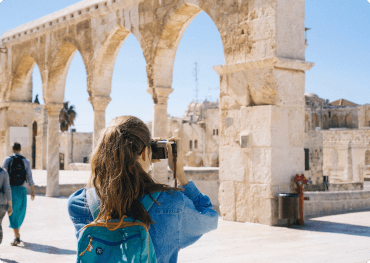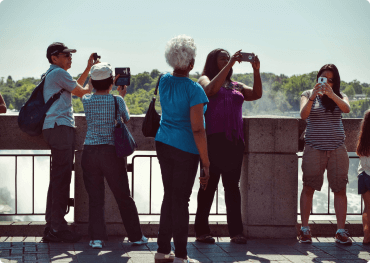
CL-509
Package Details
Day 1: Arrival to Tehran
Midnights meets and assist at Tehran international airport and transfer to hotel.
After breakfast visiting Golestan Palace & Grand Bazzar. Evening transfer to train station to go to Kerman
O/N: on Train
The Golestan Palace is the former royal Qajar complex in Iran's capital city, Tehran.The oldest of the historic monuments in Tehran, and of world heritage status, the Golestan Palace belongs to a group of royal buildings that were once enclosed within the mud-thatched walls of Tehran’s Historic Arg (citadel). It is a masterpiece of beautiful garden and buildings consist of collection of Iranian crafts and European presents from 18th and 19th century.
Golestan Palace Complex consists of 17 structures including palaces, museums, and halls. Almost all of this complex was built during the 200 years ruling of Qajarian kings. These palaces were used for many different occasions such as coronation and other important celebrations. It also consists of three main archives as the royal photographic archive collection 'Album khane', the royal library of manuscripts 'Ketabkhane Nosakhe khati' and the archive of documents 'Markaze asnad'.
The Grand Bazaar is an old historical market in Tehran, the capital of Iran.Located at the Arg Square in Southern Tehran, it is split into several corridors over 10 km in length, each specializing in different types of goods, and has several entrances, with the main being the entrance of Sabze Meydan.
In addition to shops, the Grand Bazaar of Tehran has contained banks, mosques and guest houses.
Day 2: Kerman
After breakfast drive to Mahan for visit Bagh-e Shahzadeh, Mausoleum of Shahnemat-Ollah-
E-Valli after visiting Mahan continuo to Kerman visiting old Bazaar.
O/N: Kerman
Shazdeh Garden meaning Prince’s Garden is a historical Persian garden located near (6 km away from) Mahan in Kerman province, Iran.
The garden is 5.5 hectares with a rectangular shape and a wall around it. It consists of an entrance structure and gate at the lower end and a two-floor residential structure at the upper end. The distance between these two is ornamented with water fountains that are engined by the natural incline of the land. The garden is a fine example of Persian gardens that take advantage of suitable natural climate.
A garden was built originally for Mohammad Hasan Khan Qajar Sardari Iravani ca. 1850 on this site, and was entirely remodeled and extended ca. 1870 by Abdolhamid Mirza Naserodolleh during the eleven years of his governorship in the Qajar dynasty. The current visible structure dates almost entirely to this second period, and is formally related to similar gardens designed by NaseroDolleh in Tehran. The construction was left unfinished, due to the death of Abdolhamid Mirza in the early 1890s.
The Shah Nematollah Vali Shrine is a historical complex, located in Mahan, Iran, which contains the mausoleum of Shah Nematollah Vali, the renowned Iranian mystic and poet. Shah Nematollah Vali died in 1431 aged over 100. In 1436 a shrine was erected in his honor and became a pilgrimage site; with the attention of successive rulers contributing various additions over the centuries.
Day 3: Kerman - Yazd
Morning will continue our trip to Yazd (364 km) where Marco Polo visited in 1272 and
Described as a "Nobel City" Upon arrival and then hotel check in.
O/N: Yazd
Day 4: Yazd
Morning city sightseeing visiting Zoroastrian fire temple, Amir Chakhmagh Complex,
Bagh-e Doulat Abad.
O/N: Yazd
The Yazd Atash Behram, also known as Yazd Atash Kadeh, is a temple in Yazd, to the west of Shiraz in Iran. It was built in 1934 and enshrines the Atash Bahram, meaning “Victorious Fire”, dated to 470 AD. It is one of the nine Atash Behrams, the only one of the highest grade fire in Iran where Zoroastrians have practiced their religion since 400 BC; the other eight Atash Behrams are in India. According to Aga Rustam Noshiravan Belivani, of Sharifabad, the Anjuman-i Násirí (elected Zoroastrian officials) opened the Yazd Atash Behram in the 1960s to non-Zoroastrian visitors.
Amir Chakhmaq Maidan Square in the city of Yazd is. Yazd Amir Chakhmaq of the market, relying, a mosque and two cistern dating back to the Timurid period is. Relying Amir Flint in 1330 and the mosque, Amir Flint in 1341 in the national index Iran were registered. Amyrchqmaq field, one of the most remarkable collections of historical and tourism is the city of Yazd.
Amyrjlalaldyn Chqmaq , captains and rulers of the Timurid Shahrukh in solar 8th century when the ruling was Yazd, a set of lean , square, public baths , caravanserais , monasteries , Qnatkhanh and cold water and in so doing promote the buildup of Yazd Fatima Khatun, wife, helped him.
Day 5: Yazd- Shiraz
Morning drive to Shiraz (438 km) via Abar kouh on the way visiting Pasargad (the history complex about 550 BC)
O/N: Shiraz
Pasargadae World Heritage collection is a set of ancient structures Brjaymandh from the Achaemenid the city of Pasargadae in Fars Province lies.
This total includes buildings such as Tomb of Cyrus the Great , Pasargadae mosque , declared the king's garden , the palace gates , bridges, levee House , House suite , two pavilions , waterfront, garden cress, Tomb of Cambyses , defensive structures Tel bed , inn Mozaffari , sacred ground and Bolaghi Gorge is.
This set the fifth set is registered in the World Heritage List in Iran at a meeting of UNESCO in July of 1383 in China was held due to many factors hundred per cent on the World Heritage List was registered.
In 529 BC, Cyrus the tribes of the Scythians in Central Asia (North East of Iran) attacked and are at war with massagetae was killed. He was buried in Pasargadae.
Pasargadae plain up to the height of 1900 meters above sea level, is located within the mountain. In the seventh century AH Atabaki of Slghryan barking near the tomb of Cyrus the Great Mosque in which use was made of stone palaces. To celebrate 2500 years of the Shah of Iran in 1971, the stones were returned back to their original locations. Palace location demonstrating the role and effectiveness of Greek architecture is unmistakable. Apparently when Cyrus in 545 BC Sardis (capital Lady, a city in West Turkey today) marble monuments Kings captured strongly influenced by Lady is located. He may at the same time a number of professors from Pasargadae to work Gmashthast Lady. Attractive balance of dark and light marble palace, especially at the base, closer attention. The rocks of the Sivand mentioned. Pasargad in the northern part of the province and the Zagros Mountains is located at a distance of 130 kilometers north of Shiraz. The average height of 1850 meters above sea level is plain that the area is about 190 square km. It is a mountainous region with temperate summers and cold winters. Pasargadae area dating back to the Middle Paleolithic archaeological research is based. But the most prominent cultural period of Pasargad, the Achaemenid period. Pasargadae name based on the evidence presented for the first time that the place in the Achaemenid period Dashti refers to Cyrus the Great chose as his headquarters and where to build the monuments and palaces. Pasargadae cultural-historical collection contains the tomb of Cyrus the Great, palaces gate, levee, dedicated and building stone tower ( Temple ), Castle ( Tel bed ), garden cress , bridge and is sacred ground. During the Islamic period because of the greatness of the stones used in the collections of the place, its structures and Pasargadae attributed to Prophet Solomon Solomon's mother was known as Mashhad Mashhad or Amalnby. This valuable collection of 16 June 1383 as the fifth country in the World Heritage List (UNESCO) was registered.
Day 6: Shiraz
After breakfast visiting Shiraz: Tomb of Hafez, Narenjestan-e Ghavam. Evening is free for shopping.
O/N: Shiraz
The Tomb of Hafez and its associated memorial hall, the Hāfezieh, are two memorial structures erected in the northern edge of Shiraz, Iran, in memory of the celebrated Persian poet Hafez. The open pavilion structures are situated in the Musalla Gardens on the north bank of a seasonal river and house the marble tomb of Hafez. The present buildings, built in 1935 and designed by the French architect and archaeologist André Godard, are at the site of previous structures, the best-known of which was built in 1773. The tomb, its gardens, and the surrounding memorials to other great figures are a focus of tourism in Shiraz.
Qavam House: The consistency of the prince in 1252. BC Persian rule was appointed to her home in the neighborhoods (neighborhoods Balakft), the historic buildings and residential construction that led to the formation of consistency. This sets the consistency between the public gardens known today by the name of its exterior facade famous Orangery is consistency.Between 1257 and 1267 coincided with the consistency of Nasser al-Din Shah Qajar and has been completed. The complex consists of several elements that most of these elements are Gchynh bathroom, Hosseinieh consistency, consistency schools (house beverages), inner consistency (home ornament ol), Court House consistency (Orangery), consistency and an en suite bathroom stalls and Znjyrkhanh (now defunct). Of course, there Bazarchhay in the series due to street construction Lotf Ali Khan is gone. Orangery building solar In 1345 Shiraz University were awarded between 1348 to 1358 solar Asian Institute, headed by Professor Arthur Up ham Pope, Iran was famous.In recent years, the north side basement overhaul and a museum where cultural objects donated by the Professor used the Pope maintenance.
Day 7: Shiraz - Isfahan
After breakfast trip from Shiraz to Isfahan via visiting Persepolis (the big history
Complex about 550 BC.). Upon arrival to Isfahan check in hotel.
O/N: Isfahan
Persepolis the name of one of the ancient cities of Iran that joined over the years, the capital’s stately and ceremonial monarchy at the time of the Achaemenid Empire was. In this ancient city called Persepolis palace that during the reign of Darius, Xerxes and Artaxerxes was built and was built for about 200 years. On the first day of the New Year, many groups from different countries representing Satrapyha or governments gathered in Persepolis with diverse took offerings and gifts were presented to the king.
Persepolis in 518 BCE as the new capital of the Achaemenid the gamers began. Founder of Persepolis, Darius was, of course, after his son Xerxes and his grandson Artaxerxes I to extend this series to expand it added. Many existing knowledge about the history and culture of the Achaemenid stone inscriptions and Flznvshthhayy is available for the palaces and on the walls and the tablet is engraved Sumner has estimated that the plain of Persepolis which contains 39 residential camp was in the Achaemenid period 43, 600 people had. Historians believe that Alexander the Macedonian commander Greek in 330 BC, invaded Iran and burned Persepolis and probably a large part of the books, Achaemenid art and culture destroyed by it. However, the ruins of this place is still up and archeology of its ruins signs of fire and rush to acknowledge it.
This place since 1979, one of Iran's record on the UNESCO World Heritage is.
Day 8: Isfahan
Morning city sightseeing (Naghshe jahan square, Allighapoo Palace, Imam Mosque,
Sheikh lotfolah Mosque, Old Bazaar.
O/N: Isfahan
Naqsh-e Jahan Square known as Imam Square, formerly known as Shah Square, is a square situated at the center of Isfahan city, Iran. Constructed between 1598 and 1629, it is now an important historical site, and one of UNESCO's World Heritage Sites. It is 160 meters (520 ft.) wide by 560 meters (1,840 ft.) long (an area of 89,600 square meters (964,000 sq. ft.)). The square is surrounded by buildings from the Safavid era. The Shah Mosque is situated on the south side of this square. On the west side is the Ali Qapu Palace. Sheikh Lotf Allah Mosque is situated on the eastern side of this square and at the northern side Keisaria gate opens into the Isfahan Grand Bazaar.
Ali Qapu is a grand palace in Isfahan, Iran. It is located on the western side of the Naqsh e Jahan Square, opposite to Sheikh Lotfollah Mosque, and had been originally designed as a vast portal. It is forty-eight meters high and there are seven floors, each accessible by a difficult spiral staircase. In the sixth floor, Music Hall, deep circular niches are found in the walls, having not only aesthetic value, but also acoustic.
Fresco from the portico of the palace, depicting a Persian woman.
The name Ali Qapu, from Arabic "Ālī" (meaning "imperial" or "great"), and Turkic "Qāpū" (meaning "gate"), was given to this place as it was right at the entrance to the Safavid palaces which stretched from the Naqsh e Jahan Square to the Chahar Baq Boulevard. The building, another wonderful Safavid edifice, was built by decree of Shah Abbas I in the early seventeenth century. It was here that the great monarch used to entertain noble visitors, and foreign ambassadors. Shah Abbas, here for the first time, celebrated the Nowruz (Iranian New Year) of 1006 AH / 1597 C E.
Ali Qapu is rich in naturalistic wall paintings by Reza Abbasi, the court painter of Shah Abbas I, and his pupils. There are floral, animal, and bird motifs in his works. The highly ornamented doors and windows of the palace have almost all been pillaged at times of social anarchy. Only one window on the third floor has escaped the ravages of time. Ali Qapu was repaired and restored substantially during the reign of Shah Sultan Hussein, the last Safavid ruler, but fell into a dreadful state of dilapidation again during the short reign of invading Afghans. Under the reign of Nasir Ol Din Shah e Qajar (1848–96), the Safavid cornices and floral tiles above the portal were replaced by tiles bearing inscriptions.
Sheikh Lotfollah Mosque is one of the architectural masterpieces of Safavid Iranian architecture, standing on the eastern side of Naghsh-i Jahan Square, Isfahan, Iran.
Construction of the mosque started in 1603 and was finished in 1619. It was built by the chief architect Shaykh Bahai, during the reign of Shah Abbas I of the Safavid dynasty.
The Bazaar of Isfahan or Isfahan Bazaar is a historical market in Isfahan, Iran, one of the oldest and largest bazaars in the Middle East, dating back to the 17th century. The bazaar is a vaulted two-kilometre street linking the old city with the new.
The Bazaar of Isfahan is located in downtown old Isfahan, Iran, in the northern section of the Naqsh-e Jahan Square. The main entrance called Qeisarieh and you can walk all along to the Friday mosque Jameh Mosque the oldest mosque in Isfahan, and one of the oldest in Iran.
Before you enter the Grand Bazaar, if you look back you will see the magnificent view of the square, which is one of the biggest squares in the entire world. All around the square are bazaars full of magnificent Persian handicrafts.
Day 9: Isfahan - Tehran
After breakfast check out hotel and free for shopping.
Afternoon drive to international airport.
O/N: on the way
Day 10: Departure
Early morning flight to your country and departure of Iran.
Details
Pellentesque accumsan magna in augue sagittis, non fringilla eros molestie. Sed feugiat mi nec ex vehicula, nec vestibulum orci semper. Class aptent taciti sociosqu ad litora torquent per conubia nostra, per inceptos himenaeos. Donec tristique commodo fringilla. Duis aliquet varius mauris eget rutrum. Nullam sit amet justo consequat, bibendum orci in, convallis enim. Proin convallis neque viverra finibus cursus. Mauris lacinia lacinia erat in finibus.
Pellentesque accumsan magna in augue sagittis, non fringilla eros molestie. Sed feugiat mi nec ex vehicula, nec vestibulum orci semper. Class aptent taciti sociosqu ad litora torquent per conubia nostra, per inceptos himenaeos. Donec tristique commodo fringilla.
- Specilaized Bilingual Guide
- Private Transport
- Entrance Fees
- Box Lunch,Water,Dinner and Snacks
Pellentesque accumsan magna in augue sagittis, non fringilla eros molestie. Sed feugiat mi nec ex vehicula, nec vestibulum orci semper. Class aptent taciti sociosqu ad litora torquent per conubia nostra, per inceptos himenaeos. Donec tristique commodo fringilla.
- Specilaized Bilingual Guide
- Private Transport
- Entrance Fees
- Box Lunch,Water,Dinner and Snacks
Pellentesque accumsan magna in augue sagittis, non fringilla eros molestie. Sed feugiat mi nec ex vehicula, nec vestibulum orci semper. Class aptent taciti sociosqu ad litora torquent per conubia nostra, per inceptos himenaeos. Donec tristique commodo fringilla.
- Specilaized Bilingual Guide
- Private Transport
- Entrance Fees
- Box Lunch,Water,Dinner and Snacks
Pellentesque accumsan magna in augue sagittis, non fringilla eros molestie. Sed feugiat mi nec ex vehicula, nec vestibulum orci semper. Class aptent taciti sociosqu ad litora torquent per conubia nostra, per inceptos himenaeos. Donec tristique commodo fringilla.
- Specilaized Bilingual Guide
- Private Transport
- Entrance Fees
- Box Lunch,Water,Dinner and Snacks
Pellentesque accumsan magna in augue sagittis, non fringilla eros molestie. Sed feugiat mi nec ex vehicula, nec vestibulum orci semper. Class aptent taciti sociosqu ad litora torquent per conubia nostra, per inceptos himenaeos. Donec tristique commodo fringilla.
- Specilaized Bilingual Guide
- Private Transport
- Entrance Fees
- Box Lunch,Water,Dinner and Snacks






















